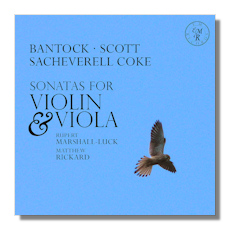
The Internet's Premier Classical Music Source
Related Links
-
Bantock Reviews
Scott Reviews - Latest Reviews
- More Reviews
-
By Composer
-
Collections
DVD & Blu-ray
Books
Concert Reviews
Articles/Interviews
Software
Audio
Search Amazon
Recommended Links
Site News
 CD Review
CD Review
British Violin & Viola Sonatas

- Granville Bantock: Violin Sonata #3 in C Major (1940)
- Cyril Scott: Viola Sonata (1953)
- Roger Sacheverell Coke:
- Violin Sonata #1 in D minor (1940-42)
Rupert Marshall-Luck, violin & viola
Matthew Rickard, piano
EM Records EMR-CDO18 75.21
Bantock (1868-1946) is the best-known of these English composers. His Violin Sonata #3 opens with a simple melody on the piano; it is quite a nice melody. The first movement, Allegro con spirito, seems slower and more peaceful than that marking suggests, but the tempos are well-chosen by the performers. It never lags and seems briefer in its nine minutes than one might expect. The violin's tone is especially good. The middle movement, called "The Dryad" with the tempo Lento sostenuto, maintains a peaceful mood. The Finale, Allegro con moto – Largamente molto lento, has some rising and soaring melody. The piano appears to be dominant here, but the quieter violin, especially in the slower portion of the movement, gives us some beautiful melody.
Cyril Scott (1879-1970) was not a conventional man, flamboyant in his youth and an adherent of occultism later. He wrote many books, mostly not about music, but including at least two autobiographical works, My Years of Indiscretion (1924), and Bone of Contention: Life Story and Confessions (1969). His performance history waxed and waned. There are recent recordings on Chandos of his concertos and orchestral music, conducted by Martyn Brabbins. There is a recent study by Sarah Collins, The Aesthetic Life of Cyril Scott (Boydell Press). I wish the present work held my attention better, especially in the relatively long opening movement. Rupert Marshall-Luck, who performs it, calls Scott a "painter in sound" and says that "its principal preoccupation is with the coloring of melodic lines and with rhythmic development…based upon cells which are often defined and delineated by means of changing time-signatures." The slow movement is a Humoresque, and the finale ranges from Adagio to Molto maestoso."
The music of Roger Sacheverell Coke (1912-1972), who was born and spent most of his life in Derbyshire on a family estate, is not well known even in his homeland but, as it happens, the July-September 2015 issue of Musical Opinion has a substantial article about his life and music by Simon Callaghan, a pianist who has recorded some of Coke's piano music. A pianist himself, influenced by Rachmaninoff and Bax, Coke is very much in the late romantic tradition, without being cloying or bombastic. The opening movement his Violin Sonata, marked "allegro rithmico, is lively and has a quick rather than drawn out ending. The Scherzo includes some appealing and lively rhythms. The "Finale, quasi una fantasia," ranges from lento to maestoso before ending very quietly.
Recommended with reservations.
Copyright © 2015, R. James Tobin





















